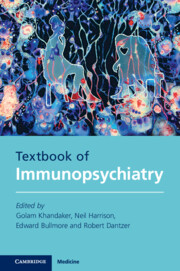Book contents
- Immunopsychiatry
- Immunopsychiatry
- Copyright page
- Contents
- Foreword
- Contributors
- Chapter 1 Basic Concepts in Immunobiology
- Chapter 2 From Psychoneuroimmunology to Immunopsychiatry: An Historical Perspective
- Chapter 3 Stress, Immune System and the Brain
- Chapter 4 The Role of Prenatal and Childhood Infection and Inflammation in Schizophrenia
- Chapter 5 The Role of Autoimmune Encephalitis in Immunopsychiatry and Lessons from Neuropsychiatric Systemic Lupus Erythematosus
- Chapter 6 Effectiveness of Immunotherapies for Psychotic Disorders
- Chapter 7 Inflammation, Sickness Behaviour and Depression
- Chapter 8 Immunotherapies for Depression
- Chapter 9 The Effect of Systemic Inflammation on Cognitive Function and Neurodegenerative Disease
- Chapter 10 Role of Inflammation in Lewy Body Dementia
- Chapter 11 The Role of Adaptive and Innate Immunity in Alzheimer’s Disease
- Chapter 12 The Immune System and Anxiety Disorders
- Chapter 13 Microbiome-Gut-Brain Interactions in Neurodevelopmental Disorders: Focus on Autism and Schizophrenia
- Chapter 14 Depression and the Adaptive Immune System
- Chapter 15 Transdiagnostic Features of the Immune System in Major Depressive Disorder, Bipolar Disorder and Schizophrenia
- Index
- Plate Section (PDF Only)
- References
Chapter 12 - The Immune System and Anxiety Disorders
Published online by Cambridge University Press: 02 September 2021
- Immunopsychiatry
- Immunopsychiatry
- Copyright page
- Contents
- Foreword
- Contributors
- Chapter 1 Basic Concepts in Immunobiology
- Chapter 2 From Psychoneuroimmunology to Immunopsychiatry: An Historical Perspective
- Chapter 3 Stress, Immune System and the Brain
- Chapter 4 The Role of Prenatal and Childhood Infection and Inflammation in Schizophrenia
- Chapter 5 The Role of Autoimmune Encephalitis in Immunopsychiatry and Lessons from Neuropsychiatric Systemic Lupus Erythematosus
- Chapter 6 Effectiveness of Immunotherapies for Psychotic Disorders
- Chapter 7 Inflammation, Sickness Behaviour and Depression
- Chapter 8 Immunotherapies for Depression
- Chapter 9 The Effect of Systemic Inflammation on Cognitive Function and Neurodegenerative Disease
- Chapter 10 Role of Inflammation in Lewy Body Dementia
- Chapter 11 The Role of Adaptive and Innate Immunity in Alzheimer’s Disease
- Chapter 12 The Immune System and Anxiety Disorders
- Chapter 13 Microbiome-Gut-Brain Interactions in Neurodevelopmental Disorders: Focus on Autism and Schizophrenia
- Chapter 14 Depression and the Adaptive Immune System
- Chapter 15 Transdiagnostic Features of the Immune System in Major Depressive Disorder, Bipolar Disorder and Schizophrenia
- Index
- Plate Section (PDF Only)
- References
Summary
Anxiety disorders, including post-traumatic stress disorder (PTSD), generalized anxiety disorder (GAD), panic disorder (PD) and phobias (including social phobia and agoraphobia), are the most common (1) and most economically costly psychiatric conditions (2). All anxiety disorders are characterized by pathological fear reactions and/or anxiety (3) in response to stimuli specific to each disorder in the absence of danger (4). Impairments in the ability to extinguish learned fear in response to specific stimuli and to learn safety behaviours are also cardinal characteristics of anxiety disorders (4). Because anxiety disorders are highly comorbid with other psychiatric conditions and adverse physical health conditions that increase mortality, including cardiovascular disease, obesity and diabetes (1,5), biomedical research has focused on defining the mechanisms underlying anxiety disorders.
- Type
- Chapter
- Information
- Textbook of Immunopsychiatry , pp. 233 - 257Publisher: Cambridge University PressPrint publication year: 2021



